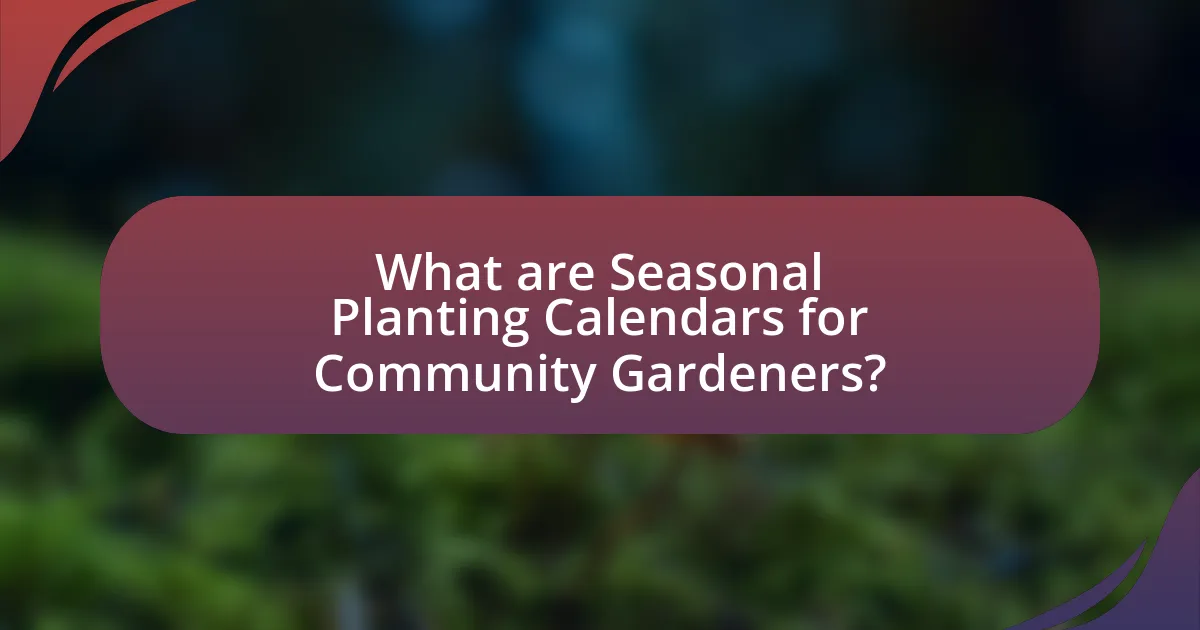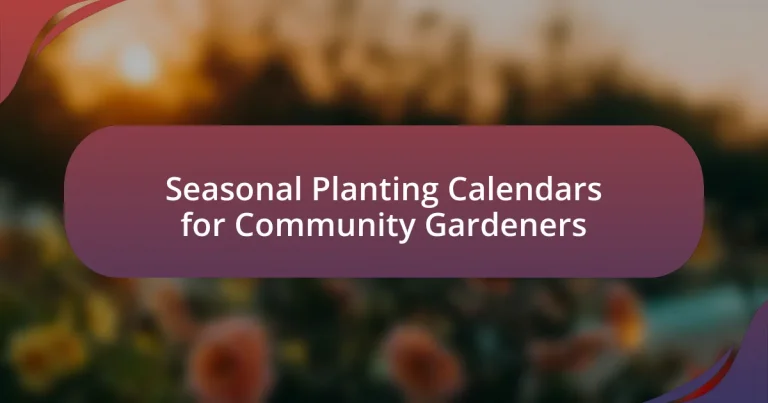Seasonal planting calendars are essential tools for community gardeners, providing specific timelines for planting, growing, and harvesting crops based on local climate conditions. These calendars enhance gardening success by optimizing planting schedules, improving crop yields by up to 30%, and fostering community engagement. Key components include planting dates, crop rotation schedules, and local climate considerations, while factors such as climate, soil conditions, and crop selection influence their creation. By following these calendars, gardeners can align their activities with seasonal weather patterns, ensuring healthier plants and more productive gardens.

What are Seasonal Planting Calendars for Community Gardeners?
Seasonal planting calendars for community gardeners are tools that provide specific timelines for planting, growing, and harvesting various crops based on local climate conditions. These calendars help gardeners optimize their planting schedules by indicating the best times to sow seeds and transplant seedlings, ensuring that crops are planted during their ideal growing seasons. For example, a planting calendar may suggest that tomatoes should be planted after the last frost date in spring, while cool-season crops like spinach can be sown in early spring or late summer. By following these guidelines, community gardeners can increase their yields and improve the overall success of their gardening efforts.
How do Seasonal Planting Calendars benefit community gardeners?
Seasonal planting calendars benefit community gardeners by providing a structured timeline for planting, cultivating, and harvesting crops based on local climate conditions. These calendars help gardeners optimize their planting schedules, ensuring that they sow seeds at the right time to maximize growth and yield. For instance, research from the University of California Cooperative Extension indicates that following a seasonal planting calendar can increase crop productivity by up to 30% by aligning planting activities with seasonal weather patterns. This strategic approach not only enhances food production but also fosters community engagement and knowledge sharing among gardeners, leading to more successful gardening experiences.
What factors influence the creation of a seasonal planting calendar?
The creation of a seasonal planting calendar is influenced by climate, soil conditions, and crop selection. Climate determines the growing season length and temperature ranges, which affect when specific crops can be planted and harvested. Soil conditions, including pH, moisture levels, and nutrient availability, influence the types of crops that can thrive in a particular area. Crop selection is based on local preferences and market demand, guiding gardeners on what to plant at specific times to optimize yield and sustainability. These factors collectively ensure that the planting calendar aligns with environmental conditions and community needs.
How do seasonal calendars improve crop yield and health?
Seasonal calendars improve crop yield and health by providing precise timing for planting, harvesting, and managing crops based on climatic conditions. These calendars help farmers align their agricultural activities with seasonal weather patterns, ensuring that crops are planted at optimal times to maximize growth and minimize risks associated with pests and diseases. Research indicates that using seasonal calendars can lead to yield increases of up to 30% in certain crops, as they allow for better resource allocation and crop management strategies tailored to specific environmental conditions.
What key components are included in a Seasonal Planting Calendar?
A Seasonal Planting Calendar includes key components such as planting dates, crop rotation schedules, seasonal crops, and local climate considerations. Planting dates specify the optimal times for sowing seeds and transplanting seedlings based on frost dates and growing seasons. Crop rotation schedules help maintain soil health and reduce pest issues by alternating different plant families. Seasonal crops indicate which plants thrive during specific times of the year, ensuring gardeners select appropriate varieties. Local climate considerations account for regional weather patterns, helping gardeners adapt their planting strategies effectively.
What types of plants are typically featured in these calendars?
Seasonal planting calendars for community gardeners typically feature vegetables, herbs, and flowers that are suitable for the local climate and growing season. Commonly included vegetables are tomatoes, peppers, lettuce, and carrots, which are chosen for their popularity and ease of cultivation. Herbs like basil, cilantro, and parsley are also frequently highlighted due to their culinary uses and growth adaptability. Additionally, flowers such as marigolds and sunflowers are often featured for their ability to attract pollinators and enhance garden aesthetics. These selections are based on regional planting times and frost dates, ensuring optimal growth and harvest periods for community gardeners.
How are planting dates determined for different regions?
Planting dates for different regions are determined primarily by local climate conditions, including temperature, frost dates, and precipitation patterns. These factors influence the growing season length and the optimal times for sowing seeds to ensure successful germination and growth. For instance, regions with longer growing seasons can support earlier planting dates, while areas with shorter seasons require later planting to avoid frost damage. Additionally, agricultural extension services and local gardening organizations often provide specific planting calendars based on historical climate data and regional agricultural practices, ensuring that gardeners align their planting schedules with the best environmental conditions for their crops.
Why is it important to follow a Seasonal Planting Calendar?
Following a Seasonal Planting Calendar is crucial for optimizing crop yields and ensuring the health of plants. This calendar provides specific timelines for planting, which align with local climate conditions and seasonal changes, allowing gardeners to select the right crops for the right time. Research indicates that crops planted at their optimal times can produce significantly higher yields; for example, planting tomatoes in late spring rather than early spring can increase production by up to 30%. Additionally, adhering to a seasonal calendar helps in pest management and disease prevention, as certain pests are more prevalent during specific times of the year. Therefore, using a Seasonal Planting Calendar enhances both productivity and sustainability in community gardening efforts.
What challenges do gardeners face without a planting calendar?
Gardeners face significant challenges without a planting calendar, primarily the risk of planting at inappropriate times, which can lead to poor crop yields. Without a schedule, gardeners may miss optimal planting windows dictated by seasonal weather patterns, resulting in plants that are either frostbitten or unable to mature before the first frost. Additionally, the lack of a planting calendar can lead to inefficient use of space and resources, as gardeners may plant incompatible crops together or fail to rotate crops effectively, which is essential for soil health. Research indicates that timely planting can increase yields by up to 30%, highlighting the importance of adhering to a planting schedule.
How does seasonal planting align with local climate conditions?
Seasonal planting aligns with local climate conditions by ensuring that crops are sown and harvested during optimal weather periods, which enhances growth and yield. For instance, cool-season crops like lettuce and peas thrive in cooler temperatures, typically planted in early spring or fall, while warm-season crops such as tomatoes and peppers require warmer soil and air temperatures, making late spring the ideal planting time. This alignment is supported by agricultural studies, such as those from the USDA, which indicate that understanding local frost dates and temperature ranges can significantly improve crop success rates.
How can community gardeners create their own Seasonal Planting Calendar?
Community gardeners can create their own Seasonal Planting Calendar by first identifying their local climate zone and understanding the specific growing seasons for their region. This involves researching the average last frost date in spring and the first frost date in fall, which are critical for determining planting times. Additionally, gardeners should consider the types of crops they wish to grow, as different plants have varying requirements for planting and harvesting.
To ensure accuracy, they can consult resources such as the USDA Plant Hardiness Zone Map, which provides detailed information on climate zones across the United States, or local agricultural extension services that offer tailored advice based on regional conditions. By compiling this information, community gardeners can create a personalized calendar that outlines optimal planting and harvesting times for their selected crops, enhancing their gardening success.
What resources are available for developing a personalized calendar?
To develop a personalized calendar for seasonal planting, community gardeners can utilize online tools such as Google Calendar, which allows for customization of planting schedules based on local climate data. Additionally, resources like the USDA Plant Hardiness Zone Map provide essential information on suitable planting times for various crops in specific regions. Gardening apps, such as GrowIt! and PlantSnap, offer personalized reminders and tips tailored to individual gardening needs. These resources collectively enable gardeners to create effective and personalized planting calendars that align with their local growing conditions.
How can gardeners collaborate to share planting schedules?
Gardeners can collaborate to share planting schedules by utilizing digital platforms such as shared calendars, social media groups, or community gardening apps. These tools allow gardeners to input their planting dates, share seasonal information, and coordinate planting efforts effectively. For instance, platforms like Google Calendar enable multiple users to access and update a shared schedule, ensuring all members are informed about optimal planting times. Research indicates that community engagement through digital tools enhances collaboration and improves gardening outcomes, as seen in studies on community-supported agriculture initiatives.
What are the common mistakes to avoid when using a Seasonal Planting Calendar?
Common mistakes to avoid when using a Seasonal Planting Calendar include planting at the wrong time, neglecting local climate variations, and failing to consider soil conditions. Planting at the wrong time can lead to poor germination and crop failure, as many plants have specific temperature and light requirements. Neglecting local climate variations means that gardeners may not account for microclimates, which can significantly affect plant growth. Additionally, failing to consider soil conditions, such as pH and nutrient levels, can hinder plant development and yield. These mistakes can be avoided by thoroughly researching local growing conditions and adhering to the specific guidelines provided in the seasonal planting calendar.
How can misinterpretation of planting dates affect garden success?
Misinterpretation of planting dates can significantly hinder garden success by leading to improper timing for sowing seeds or transplanting seedlings. When gardeners plant too early or too late, they risk exposure to adverse weather conditions, such as frost or heat stress, which can damage or kill young plants. For instance, planting warm-season crops like tomatoes before the last frost date can result in stunted growth or plant death, as these crops require warmer soil temperatures to thrive. Additionally, incorrect planting dates can disrupt the growth cycle, leading to reduced yields or poor-quality produce. Research indicates that adhering to accurate planting schedules can improve crop performance and maximize harvests, emphasizing the importance of understanding local climate patterns and seasonal variations.
What are the consequences of ignoring local climate variations?
Ignoring local climate variations can lead to significant agricultural failures and reduced crop yields. When gardeners do not account for specific climate conditions, such as temperature fluctuations, rainfall patterns, and seasonal changes, they risk planting crops at inappropriate times, which can result in poor growth or total crop loss. For instance, a study by the National Oceanic and Atmospheric Administration (NOAA) highlights that mismatched planting schedules due to climate ignorance can decrease yields by up to 50% in certain regions. Additionally, ignoring these variations can lead to increased pest and disease pressures, as certain pests thrive in specific climatic conditions, further jeopardizing the success of community gardens.
What practical tips can enhance the use of Seasonal Planting Calendars?
To enhance the use of Seasonal Planting Calendars, community gardeners should regularly update their calendars based on local climate conditions and seasonal changes. This practice ensures that gardeners are planting at optimal times for their specific region, which can lead to better crop yields. Additionally, incorporating local frost dates and rainfall patterns into the calendar can provide more accurate planting and harvesting timelines. Research indicates that aligning planting schedules with local environmental factors can increase productivity by up to 30%, as evidenced by studies from agricultural extension services. Furthermore, sharing experiences and adjustments among community members can foster a collaborative approach, allowing for the exchange of successful strategies tailored to the local ecosystem.





